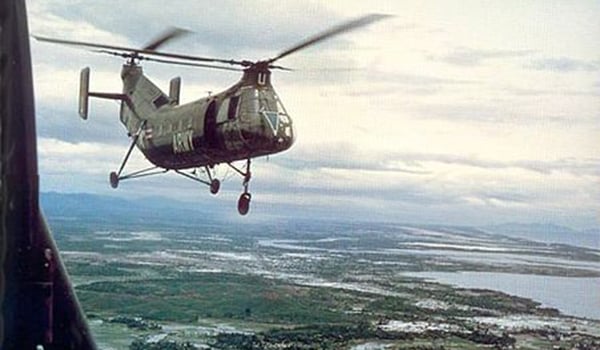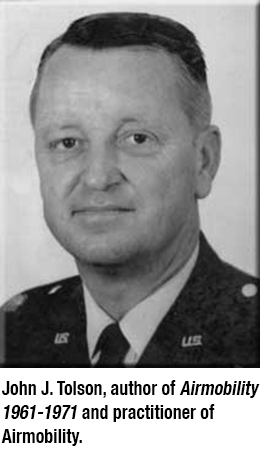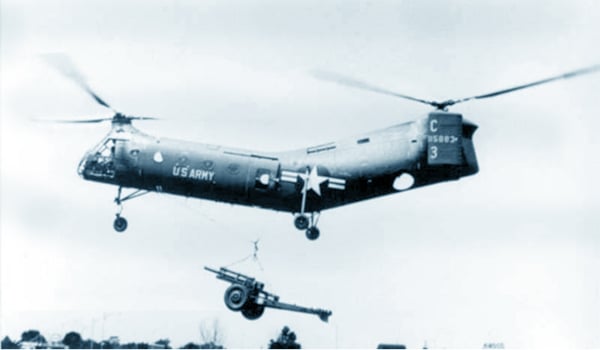
November 16, 1962 / By Mark Albertson: Saigon, December 11, 1961, USS Card (AKV-40) offloaded 82 U.S. Army H-21 helicopters and 400 men.(1) Units in question were the 57th Transportation Company (Light Helicopter), out of Fort Lewis, Washington; and, from Fort Bragg, North Carolina, the 8th Transportation Company (Light Helicopter). Before the 1st Cavalry Division (Airmobile), 11th Air Assault Division (Test) or even the Howze Board, the Army was already forging the Airmobility Concept in the jungles of Vietnam.

The Flying Banana’ carried the ball as that vehicle for Airmobility during the early stages of the Vietnam conflict.
Not two weeks after the arrival of the American contingent, it was thrown into action, the first battlefield test of Airmobility in the Vietnam War, Operation: CHOPPER. Some 1,000 South Vietnamese troops were airlifted to engage the Viet Cong some ten miles west of Saigon. “Major George D. Hardesty, Jr. of the 8th Transportation Company and Major Robert J. Dillard of the 57th could report that their units had performed outstandingly under their first baptism of fire.”(2)
The airlifting of South Vietnamese troops by Army Aviators generated priceless, and in some cases, hard-earned experience, with regards to shuttling foot sloggers in and out of battle by helicopter. Experience that would pay off handsomely a few years down the road.
 Yet the enemy was learning, too. War is almost never a one-sided affair. And when one combatant introduces a weapon or new concept, the opponent tries to foster a countermeasure. What is outlined below appears on pages 2 and 3 of LTG John J. Tolson’s valuable work, Vietnam Studies, 1961-1971, concerning North Vietnam’s attempt to counter the Airmobility Concept. It is based on a captured instruction pamphlet on how to deal with enemy airborne units, seized on November 16, 1962:
Yet the enemy was learning, too. War is almost never a one-sided affair. And when one combatant introduces a weapon or new concept, the opponent tries to foster a countermeasure. What is outlined below appears on pages 2 and 3 of LTG John J. Tolson’s valuable work, Vietnam Studies, 1961-1971, concerning North Vietnam’s attempt to counter the Airmobility Concept. It is based on a captured instruction pamphlet on how to deal with enemy airborne units, seized on November 16, 1962:
“Enemy Reaction
“It is interesting to note how the enemy viewed this increasing airmobility potential. The following is a translation of an extract from a North Vietnamese instruction pamphlet captured on November 16, 1962:
“It can be said that all the recent augmentations of forces that the USA has sent to the Diem government were primarily intended to strengthen the Diem rear area forces, increase their ability to pass information rapidly and the wide employment of helicopters in the movement of troops. Therefore if we can destroy or greatly reduce the enemy’s heliborne capability we will, in essence, have destroyed the mobility necessary to the US raid tactics. Although we have succeeded in inflicting some loss on the enemy in his heliborne operations the enemy has in some places caused us fairly heavy losses. We must therefore find means of coping with the enemy’s helicopter tactics. Widespread efforts must be directed to combating heliborne landings and shooting at helicopters. Following are the advantages which the enemy enjoys due to his employment of heliborne strike tactics:
- Careful planning and preparations are possible together with complete mobility in an attack, support or relieving role.
- Secrecy can be preserved and surprise strikes can be accomplished.
- Landings can be effected deep in our rear areas with the capability to attack and withdraw rapidly.
- An appropriate means of destroying our forces while they are still weak.
However, these tactics suffer the following disadvantages:
- The population in our rear areas is on our side and will resist the enemy in every way.
- Small forces are usually employed by the enemy in their deep strikes and if counterattacked may find it difficult to withdraw.
- Heliborne operations require the latest information (old info may have lost its timeliness and new info must be checked for accuracy). If the time is taken to acquire confirmatory info then the situation may have changed rendering the info inaccurate.
- The enemy’s strike elements are usually unfamiliar with the terrain and can easily be surrounded and rapidly defeated.
- The present available helicopters prevent the enemy from employing large forces (although this is only a temporary disadvantage it will take the enemy some time before he will be able to overcome it.)
- The effectiveness of heliborne tactics is greatly reduced in forested and jungle covered mountain areas where a clear knowledge of the nature of the terrain cannot be discerned from the air, where landings are difficult and ambushes easily employed against the landings.
- The disadvantages inherent in helicopters are difficult to overcome. If they are flown slow or low they are vulnerable to ground fire; every flying hour must be complemented by 3 hours ground maintenance; they cannot be flown for more than 70 hours in any 2 or 3 days (TN: Obvious typographical or technical error. 10 hours in 2 or 3 days seems appropriate); the helicopter consumes much fuel, carrying a full load of troops its fuel capacity is reduced and as a consequence its range is reduced, as a result the starting point for heliborne operations is usually near the objective and thus the enemy’s element of surprise can be compromised. A landing right within our position is the most effective, but also subject to coming under our firepower while a landing outside of our position, though avoiding our firepower, loses the element of surprise.
“It is obvious that the Viet Cong, in spite of all their polemics, had recognized that the advent of airmobility in Vietnam had changed the name of the game. True, the allies had much to learn about the employment of this new capability, but the war would never be the same.”(3)
Notes

USNS Card listing following attack by VC commandos in Saigon, May 2, 1964.
(1) USNS Card began life with a Maritime Commission hull number 178, style type C3-S-A1 merchant hull. Procured by the Navy on May 1, 1942, she was classified as an Aircraft Escort Vessel, (AVG-11). Reclassified on August 20, 1942 as an Auxiliary Aircraft Carrier, (ACV-11); then re-designated on July 15, 1943 as an Escort Carrier, (CVE-11). Deemed an Escort Helicopter Aircraft Carrier (CVHE-11), June 12, 1955, she was assigned to the Military Sea Transportation Service and crewed by civilians. On July 1, 1958, Card was classified as a Utility Aircraft Carrier, ([T-] CVU-1). Then she was re-designated a Cargo Ship and Aircraft Ferry, ([T-] AKV-40, on May 7, 1959. On the evening of May 2, 1964, VC commandos affixed explosives to the Card’s bottom. Water cascaded in, causing her to settle at her moorings in Saigon. Card was repaired and reentered service on December 11. AKV-40 entered Reserve Fleet Status, March 10, 1970, in Olympia, Washington. Withdrawn from Reserve Fleet Status on June 9, 1971, Card was relegated for scrap.

H-21 hoisting a field gun.
<(2) See page 4, chapter 1, “The Growth of the Airmobile Concept,” Vietnam Studies: Airmobility, 1961-1971, by LTG John J. Tolson, 1989.
(3) See pages 27 and 28, Tolson.
Sources:
Mooney, James L., “Card,” Dictionary of American Naval Fighting Ships, Navy Department, Office of Chief of Naval Operations, Naval History Division, 1959-1981. This version is maintained by Hazegray, which contains the histories of American naval vessels as far back as the Civil War and the American Revolution.
NavSource Online: Escort carrier Archive, USS Card (ACV-11) (later CVE-11, CVHE-11, CVU-11 and AKV-40).








